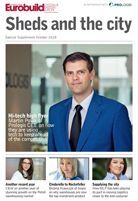Rafał Ostrowski, ’Eurobuild CEE’: What is Prologis’ strategy for the company’s growth in the CEE region?
Martin Polák, managing director, regional head, Prologis, Central and Eastern Europe: Our global strategy is to construct premises in high-barrier, high-growth markets. Mainly due to urbanisation and growing e-commerce requirements, fulfilling consumers’ expectations with speedy last mile delivery has become critical. Therefore we focus on established markets and locations close to the main population and consumption centres. Currently we have nine logistics facilities totalling 200,000 sqm under construction in all four countries in the CEE region. This is strong evidence of how the CEE market is among the best performing of those we are active in and is also a reflection of the commitment of Prologis CEE’s whole team to turning focused strategy into market-leading performance.
Which countries and markets within the CEE region are































































